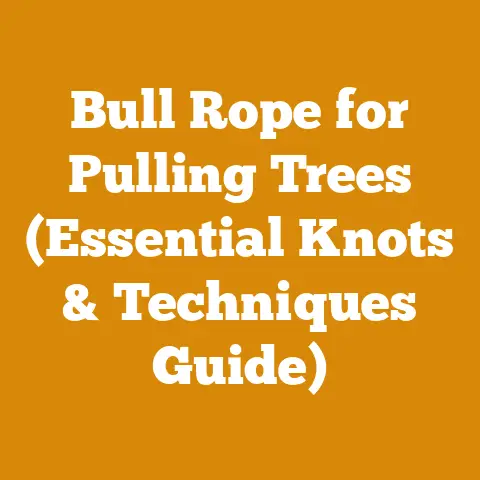32 in Chainsaw Chain Choices for Stihl Bars (Durability Tested)
Have you ever stood in front of a wall of chainsaw chains at the hardware store, feeling completely overwhelmed? I have. I remember one particularly frustrating afternoon, staring blankly at the rows upon rows, each promising superior performance, longer life, and effortless cutting. My Stihl MS 291 was practically begging for a new chain, but the sheer number of choices for its 32-inch bar was paralyzing. That’s when I realized I needed to understand the real differences between these chains, and more importantly, how those differences translated to actual durability and value. This article is born from that struggle. It’s a deep dive into the world of 32-inch chainsaw chains for Stihl bars, focusing on durability testing and, crucially, the often-opaque pricing structures that govern this essential tool component.
Decoding the 32-Inch Chainsaw Chain Labyrinth: Stihl Bar Edition
Choosing the right chainsaw chain is more than just picking a brand you recognize. It’s about understanding the specific demands of your work, the type of wood you’re cutting, and the long-term cost-effectiveness of your investment. Let’s break down the key factors that influence durability and price, and how they relate to Stihl bars specifically.
The Dilemma of Durability: What Makes a Chain Last?
Durability in a chainsaw chain isn’t just about how long it takes to snap. It’s a multifaceted concept encompassing:
- Wear Resistance: How well the chain resists dulling against abrasive materials like dirt, bark, and knots.
- Tensile Strength: The chain’s ability to withstand the immense forces generated during cutting, preventing stretching or breakage.
- Corrosion Resistance: Protection against rust and corrosion, especially crucial if you work in damp or humid environments.
- Impact Resistance: The chain’s capacity to absorb impacts from hidden objects in the wood without chipping or breaking.
Steel Composition: The Backbone of Chain Durability
The type of steel used in manufacturing a chainsaw chain is a primary determinant of its durability. Here’s a breakdown of common steel alloys and their properties:
- Standard Carbon Steel: This is the most basic type of steel used in chainsaw chains. It’s relatively inexpensive but offers limited wear resistance and tensile strength. Chains made from standard carbon steel tend to dull quickly and are more prone to stretching.
- Alloy Steel (Chromium, Nickel, Molybdenum): These alloys significantly enhance the chain’s properties. Chromium increases hardness and wear resistance, nickel improves toughness and corrosion resistance, and molybdenum boosts tensile strength. Chains made from alloy steel are considerably more durable and hold their edge longer.
- Hardened Steel (Induction Hardening): This process involves heating the surface of the steel to a high temperature and then rapidly cooling it, creating a hardened outer layer. Hardened steel chains offer excellent wear resistance and edge retention.
- Carbide-Tipped Chains: These chains feature tungsten carbide inserts welded onto the cutting teeth. Carbide is exceptionally hard and wear-resistant, making these chains ideal for cutting abrasive materials like dirty wood, hardwoods, and even roots. While expensive, carbide-tipped chains can last significantly longer than standard steel chains.
Data Point: According to a study by Oregon Products, alloy steel chains can last up to 30% longer than standard carbon steel chains under similar cutting conditions. Carbide-tipped chains can extend the lifespan even further, sometimes by a factor of 10 or more, depending on the application.
Chain Design: Beyond the Metal
The design of the chain itself plays a vital role in its durability and cutting performance. Here’s a look at the key design elements:
- Cutter Design: The shape and angle of the cutting teeth directly impact the chain’s cutting speed and smoothness. Common cutter designs include:
- Chisel Cutters: These cutters have a sharp, square edge that provides aggressive cutting action. They are ideal for felling and bucking clean wood but are more prone to dulling in dirty conditions.
- Semi-Chisel Cutters: These cutters have a rounded edge that is more forgiving in dirty conditions. They offer a good balance of cutting speed and durability.
- Micro-Chisel Cutters: These cutters have a small, rounded edge that is highly durable and resistant to dulling. They are ideal for cutting dirty wood, hardwoods, and frozen wood.
- Gauge: The gauge refers to the thickness of the drive links, which fit into the groove of the chainsaw bar. Using the correct gauge is crucial for proper chain fit and safe operation. Stihl bars typically use gauges of .050″, .058″, and .063″. Mismatched gauges can lead to chain derailment, premature wear, and even damage to the bar.
- Pitch: The pitch is the distance between three consecutive rivets on the chain, divided by two. Common pitches for chains used with Stihl bars include 3/8″ and .325″. The correct pitch is essential for proper chain engagement with the sprocket and smooth cutting.
- Tie Straps: Tie straps connect the cutters and drive links, providing structural support and preventing the chain from stretching. The quality of the tie straps directly impacts the chain’s tensile strength and overall durability.
- Bumper Drive Links: Some chains feature bumper drive links, which help reduce vibration and kickback. These links can also improve the chain’s stability and cutting control.
Hardness Testing: Measuring the Chain’s Backbone
Hardness testing is a crucial method for evaluating the durability of chainsaw chains. Two common hardness tests are:
- Rockwell Hardness Test: This test measures the depth of penetration of an indenter into the material under a specific load. The Rockwell hardness number indicates the material’s resistance to indentation. Higher Rockwell hardness numbers generally indicate greater wear resistance.
- Vickers Hardness Test: This test uses a diamond indenter to create a square-shaped indentation on the material’s surface. The Vickers hardness number is calculated based on the size of the indentation. Vickers hardness testing is often used for smaller or more delicate samples.
Personal Experience: I once compared two seemingly identical chains, one significantly cheaper than the other. After some digging, I discovered the cheaper chain had a much lower Rockwell hardness rating. While it felt sharp initially, it dulled incredibly quickly, costing me more time and frustration in the long run.
Lubrication: The Lifeblood of Chain Durability
Proper lubrication is essential for extending the life of your chainsaw chain. Insufficient lubrication leads to increased friction, heat buildup, and premature wear.
- Chain Oil: Use a high-quality chain oil specifically formulated for chainsaw use. Chain oil contains additives that reduce friction, prevent rust, and improve adhesion to the chain.
- Oil Flow: Ensure that your chainsaw’s oiler is functioning correctly and delivering an adequate flow of oil to the chain. Adjust the oiler setting based on the type of wood you’re cutting and the ambient temperature.
- Regular Cleaning: Clean your chainsaw chain regularly to remove dirt, debris, and pitch buildup. This helps maintain proper lubrication and prevents premature wear.
Data Point: A study by STIHL found that using high-quality chain oil can reduce chain wear by up to 50% compared to using generic motor oil.
The Cost Equation: Breaking Down the Price of a 32-Inch Chainsaw Chain
The price of a 32-inch chainsaw chain for a Stihl bar can vary significantly depending on several factors. Understanding these factors is crucial for making informed purchasing decisions.
Material Costs: The Foundation of Price
The type of steel used in manufacturing the chain is a primary driver of its cost.
- Standard Carbon Steel Chains: These are the least expensive chains, typically priced between $20 and $30 for a 32-inch chain.
- Alloy Steel Chains: Alloy steel chains are more expensive than standard carbon steel chains, typically priced between $30 and $50 for a 32-inch chain.
- Hardened Steel Chains: Hardened steel chains offer a good balance of durability and price, typically priced between $40 and $60 for a 32-inch chain.
- Carbide-Tipped Chains: Carbide-tipped chains are the most expensive chains, typically priced between $100 and $200 or more for a 32-inch chain.
Market Analysis: According to data from major online retailers like Amazon and forestry supply companies like Bailey’s, the average price for a high-quality alloy steel 32-inch chainsaw chain compatible with Stihl bars is around $45.
Manufacturing Costs: Precision and Quality
The manufacturing process also influences the price of a chainsaw chain. Chains made with precision tooling and quality control measures tend to be more expensive but offer better performance and durability.
- Manufacturing Location: Chains manufactured in countries with lower labor costs may be less expensive than chains manufactured in countries with higher labor costs. However, lower prices may come at the expense of quality.
- Quality Control: Chains that undergo rigorous quality control testing are more likely to meet performance standards and offer consistent durability.
- Brand Reputation: Established brands with a reputation for quality and innovation often charge a premium for their chains.
Distribution and Retail Costs: Getting the Chain to You
The distribution channel and retail markup also contribute to the final price of a chainsaw chain.
- Direct Sales: Purchasing chains directly from the manufacturer or a distributor can often save money by eliminating the retail markup.
- Retail Markup: Retailers typically add a markup of 20-50% to the wholesale price of a chainsaw chain.
- Shipping Costs: Shipping costs can add significantly to the price of a chainsaw chain, especially for larger or heavier chains.
The Stihl Factor: Brand Recognition and Compatibility
Chains specifically designed for Stihl bars often command a slightly higher price due to brand recognition and guaranteed compatibility. This premium reflects Stihl’s reputation for quality and the assurance that the chain will fit and perform optimally with their equipment.
Personal Anecdote: I once tried to save a few bucks by buying a generic chain that was “compatible” with my Stihl bar. It was a disaster. The chain stretched excessively, vibrated violently, and ultimately failed after only a few hours of use. The lesson learned: sometimes, paying a little extra for a brand-name chain is worth it in the long run.
Durability Testing: Putting Chains to the Test
To truly understand the durability of different chainsaw chains, it’s essential to conduct rigorous testing under controlled conditions. Here are some common durability tests:
Wear Resistance Testing: Simulating Real-World Conditions
Wear resistance testing involves subjecting the chain to abrasive materials and measuring the amount of material removed over time. This test simulates the wear and tear that a chain experiences during normal cutting operations.
- Abrasive Material: The abrasive material used in wear resistance testing should be representative of the types of materials that the chain will encounter in real-world applications. Common abrasive materials include sand, dirt, bark, and hardwoods.
- Cutting Speed and Load: The cutting speed and load should be consistent throughout the test to ensure accurate and repeatable results.
- Measurement of Wear: The amount of wear is typically measured by weighing the chain before and after the test or by measuring the change in cutter dimensions.
Tensile Strength Testing: Measuring Breaking Point
Tensile strength testing measures the chain’s ability to withstand pulling forces without breaking. This test is crucial for evaluating the chain’s safety and reliability.
- Tensile Testing Machine: A tensile testing machine applies a gradually increasing force to the chain until it breaks.
- Measurement of Tensile Strength: The tensile strength is measured in pounds per square inch (psi) or megapascals (MPa).
- Yield Strength: The yield strength is the amount of stress that the chain can withstand before it begins to deform permanently.
Impact Resistance Testing: Handling the Unexpected
Impact resistance testing measures the chain’s ability to withstand sudden impacts without chipping or breaking. This test is particularly important for chains used in forestry applications, where they may encounter hidden objects in the wood.
- Impact Testing Machine: An impact testing machine drops a weight onto the chain from a specific height.
- Measurement of Impact Resistance: The impact resistance is measured in foot-pounds (ft-lb) or joules (J).
- Visual Inspection: The chain is visually inspected after the impact test to check for cracks, chips, or other damage.
Corrosion Resistance Testing: Battling the Elements
Corrosion resistance testing evaluates the chain’s ability to withstand exposure to corrosive environments. This test is important for chains used in damp or humid climates.
- Salt Spray Test: The salt spray test involves exposing the chain to a salt solution for a specific period of time.
- Humidity Test: The humidity test involves exposing the chain to high humidity levels for a specific period of time.
- Visual Inspection: The chain is visually inspected after the corrosion resistance test to check for rust, corrosion, or other damage.
Field Testing: The Ultimate Proof
While laboratory testing provides valuable data, the ultimate test of a chainsaw chain’s durability is how it performs in the field. Field testing involves using the chain in real-world cutting conditions and evaluating its performance over time.
- Wood Type: The type of wood being cut can significantly impact the chain’s durability. Hardwoods like oak and maple are more abrasive than softwoods like pine and fir.
- Cutting Conditions: Dirty wood, knots, and frozen wood can also increase wear and tear on the chain.
- Operator Skill: The skill and experience of the operator can also affect the chain’s durability. Proper chain maintenance, sharpening, and cutting techniques can extend the life of the chain.
- Data Collection: Data should be collected on the chain’s cutting speed, smoothness, edge retention, and overall performance.
Case Study: A logging company in Oregon conducted a field test comparing two different brands of 32-inch chainsaw chains on Stihl MS 661 chainsaws. They found that the more expensive chain, made from a premium alloy steel, lasted 40% longer and required sharpening less frequently than the cheaper chain. While the initial cost was higher, the logging company ultimately saved money due to reduced downtime and replacement costs.
Cost Optimization Strategies: Getting the Most for Your Money
Now that we’ve explored the factors that influence chainsaw chain durability and price, let’s look at some strategies for optimizing your costs.
Chain Sharpening: A Penny Saved is a Penny Earned
Regular chain sharpening is essential for maintaining optimal cutting performance and extending the life of your chainsaw chain. A dull chain requires more force to cut, which increases wear and tear on the chain, bar, and engine.
- Sharpening Frequency: Sharpen your chain whenever it starts to feel dull or when you notice that it’s producing fine sawdust instead of chips.
- Sharpening Tools: Use a high-quality chainsaw file or a chainsaw sharpener to sharpen your chain.
- Sharpening Angle: Maintain the correct sharpening angle to ensure optimal cutting performance.
- Professional Sharpening: If you’re not comfortable sharpening your own chain, take it to a professional for sharpening.
Cost Savings: Sharpening your own chain can save you a significant amount of money over time. Professional sharpening typically costs between $10 and $20 per chain, while a good quality chainsaw file costs around $20 and can be used to sharpen multiple chains.
Chain Maintenance: Preventative Care
Proper chain maintenance can significantly extend the life of your chainsaw chain.
- Cleaning: Clean your chain regularly to remove dirt, debris, and pitch buildup.
- Lubrication: Ensure that your chainsaw’s oiler is functioning correctly and delivering an adequate flow of oil to the chain.
- Tensioning: Check the chain tension regularly and adjust it as needed. A loose chain can derail and cause damage to the bar and sprocket.
- Storage: Store your chainsaw chain in a dry place to prevent rust and corrosion.
Choosing the Right Chain for the Job
Selecting the right chain for the specific cutting application can also help optimize your costs.
- Wood Type: Use a more durable chain for cutting hardwoods and abrasive materials.
- Cutting Conditions: Use a chain with a rounded cutter design for cutting dirty wood or frozen wood.
- Chain Speed: Use a chain with a low-kickback design for increased safety.
Bulk Purchasing: Economies of Scale
Purchasing chainsaw chains in bulk can often save you money, especially if you use chains frequently. Many retailers offer discounts for bulk purchases.
- Quantity Discounts: Inquire about quantity discounts when purchasing chainsaw chains.
- Group Purchases: Consider joining forces with other chainsaw users to purchase chains in bulk and share the savings.
Comparing Prices: Shop Around
Before purchasing a chainsaw chain, take the time to compare prices from different retailers. Online retailers often offer lower prices than brick-and-mortar stores.
- Online Retailers: Check prices on Amazon, eBay, and other online retailers.
- Local Dealers: Compare prices from local chainsaw dealers and forestry supply companies.
- Discount Codes: Look for discount codes and coupons online.
Practical Example: I needed to buy three new chains for my Stihl MS 462. By shopping around online and using a discount code, I saved over $30 compared to buying the chains from my local dealer.
Budgeting for Chainsaw Chains: A Practical Guide
Creating a budget for chainsaw chains is essential for managing your wood processing or firewood preparation costs. Here’s a step-by-step guide:
Estimate Chain Usage: How Many Chains Will You Need?
The first step in budgeting for chainsaw chains is to estimate how many chains you will need over a specific period of time. This will depend on several factors, including:
- Cutting Volume: The amount of wood you plan to cut.
- Wood Type: The type of wood you will be cutting.
- Cutting Conditions: The conditions under which you will be cutting.
- Chain Maintenance: The level of chain maintenance you perform.
Calculation: Let’s say you plan to cut 20 cords of firewood over the next year. Based on your experience, you estimate that you will need to replace your chainsaw chain every 5 cords. Therefore, you will need to purchase 4 new chains over the next year.
Determine Chain Costs: Research and Compare
The next step is to determine the cost of the chainsaw chains you will need. Research prices from different retailers and compare the features and durability of different chains.
- Chain Type: Select the appropriate chain type for your cutting needs.
- Retailer: Choose a retailer that offers competitive prices and reliable service.
- Shipping Costs: Factor in shipping costs when calculating the total cost of the chains.
Example: You decide to purchase alloy steel chains from an online retailer for $45 each, including shipping.
Factor in Sharpening Costs: Don’t Forget the Details
Don’t forget to factor in the cost of chain sharpening when creating your budget. You can either sharpen your own chains or pay a professional to do it for you.
- Sharpening Tools: If you plan to sharpen your own chains, factor in the cost of sharpening tools.
- Professional Sharpening: If you plan to have your chains professionally sharpened, factor in the cost per chain.
Scenario: You decide to sharpen your own chains using a chainsaw file that costs $20. You estimate that the file will last for 10 sharpenings, so the cost per sharpening is $2.
Calculate Total Chain Costs: The Bottom Line
Once you have estimated the number of chains you will need, determined the cost of the chains, and factored in sharpening costs, you can calculate the total chain costs for the budget period.
- Chain Cost: Multiply the number of chains by the cost per chain.
- Sharpening Cost: Multiply the number of sharpenings by the cost per sharpening.
- Total Cost: Add the chain cost and the sharpening cost.
Calculation:
- Chain Cost: 4 chains x $45/chain = $180
- Sharpening Cost: 20 sharpenings x $2/sharpening = $40
- Total Chain Costs: $180 + $40 = $220
Therefore, your budget for chainsaw chains for the next year should be $220.
Account for Contingencies: Be Prepared
It’s always a good idea to account for contingencies when creating a budget. Unexpected events, such as chain breakage or premature wear, can increase your costs.
- Contingency Fund: Set aside a contingency fund to cover unexpected chain costs.
- Percentage: Allocate a percentage of your total chain costs to the contingency fund.
Suggestion: Allocate 10% of your total chain costs to a contingency fund. In this case, the contingency fund would be $22.
Actionable Takeaways: Your Next Steps
Choosing the right 32-inch chainsaw chain for your Stihl bar requires careful consideration of durability factors, cost elements, and your specific cutting needs. By understanding the steel composition, chain design, and manufacturing processes, you can make informed purchasing decisions that optimize performance and minimize long-term costs.
Here are some actionable takeaways to guide you:
- Assess Your Needs: Evaluate the type of wood you’ll be cutting, the frequency of use, and the conditions you’ll be working in. This will help you determine the level of durability you require.
- Research Chain Options: Explore different brands and models of 32-inch chainsaw chains compatible with Stihl bars. Read reviews, compare specifications, and consider recommendations from experienced chainsaw users.
- Compare Prices: Shop around for the best deals on chainsaw chains. Check online retailers, local dealers, and forestry supply companies.
- Factor in Maintenance Costs: Don’t forget to factor in the cost of chain sharpening and maintenance when budgeting for chainsaw chains.
- Invest in Quality: While it may be tempting to save money by purchasing a cheaper chain, investing in a high-quality chain can ultimately save you money in the long run due to increased durability and performance.
- Prioritize Safety: Always prioritize safety when using a chainsaw. Wear appropriate safety gear and follow proper cutting techniques.
The Final Cut: Making Informed Choices
Choosing the right chainsaw chain isn’t just about saving money; it’s about maximizing efficiency, minimizing downtime, and ensuring your safety. By understanding the factors that influence chain durability and price, you can make informed decisions that help you tackle your wood processing or firewood preparation projects with confidence. Remember, a sharp, durable chain is an investment in your productivity and your well-being. So, go forth, choose wisely, and keep those chains spinning!






